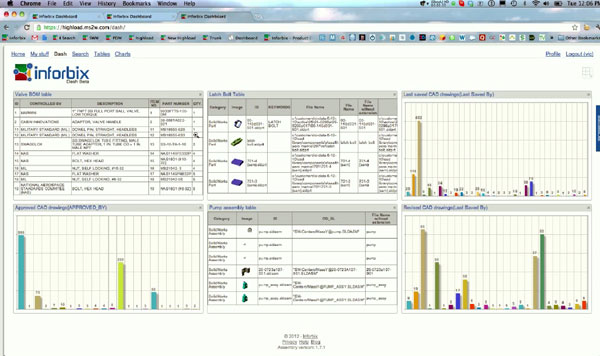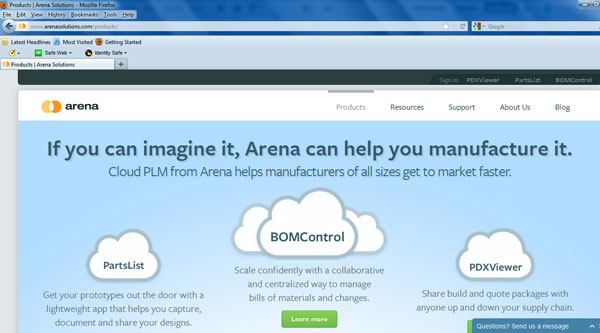Latest News
June 1, 2012
By Kenneth Wong
At first glance, a product lifecycle management (PLM) system for a small business sounds silly, like a chauffeured Mercedes for someone needing a cab, or a private jet for someone who needing a cheap flight home. In fact, about 10 years ago, PLM vendors catered almost exclusively to those who made, or could afford, Mercedes and jets. The rest made do with Excel or a homegrown system.
But the economic landscape and technology have changed quite a bit since then. Several PLM providers have figured out ways to repackage their large-enterprise products so they can be applied to smaller enterprises, at a more reasonable cost. There are also new providers who are small and midsize themselves. They continue to develop and provide the kind of no-frills data management and project management solutions their peers could use. These products are often characterized by low IT overhead, fast implementation, and modular structure (you can adopt them incrementally as your needs grow).
The real game changer is the cloud, the internet’s ubiquitous reach and accessibility. By unshackling PLM from the previous client-server architecture to web-hosted structure, some providers managed to deliver solutions with unprecedented affordability. They now offer Software-as-a-Service (SaaS) PLM subscriptions priced below $100 per user, per month—something unimaginable 10 years go.
The mobile army—the growing population of professionals who insist on using smartphones and tablets—are also a reckoning force. With the emphasis shifting from desktop clients to tablets and phones, all you need to access your PLM system may be a mobile app. With this revolution (mobilution?), a greater number of people are now poised to participate in new product introduction, change order requests, design revisions, supply chain management, and more—possibly without ever signing on to a formal PLM system or launching a CAD program.
Crowd in the Cloud
When Autodesk decided to enter the PLM market it once mocked, the company knew it couldn’t offer the same type of software and services its competitors had been selling for years. Bypassing the traditional client-server approach, Autodesk chose instead to house its PLM system in the cloud, as a series of web-hosted modules.

Autodesk’s reversal of its position on PLM led to the launch of Autodesk PLM 360, a series of web-hosted modules available by subscription.
The cloud was already getting a bit crowded, with a number of smaller PLM providers offering a variety of specialized SaaS applications. Arena Solutions, for instance, has been offering SaaS PLM since the mid-1990s. Newcomers like Inforbix and Kenesto also rely heavily on the cloud. What distinguishes Autodesk’s solution is the comprehensiveness and price. Many other SaaS PLM providers offer a web-hosted software interface that performs a specific set of functions. For Inforbix, the focus is search and retrieval of product data. For Kenesto, the focus is business process automation. Arena Solutions’ specialty is bill of material (BOM) management.
By contrast, Autodesk PLM 360, the company’s SaaS PLM brand, comes with a buffet-style spread, covering business process, BOM, supply chain, change management, incident report and much more. The price of admission to the buffet, too, is almost irresistible: The first three users in your account get in for free. You may add additional users at $25 to $75 per user per month, through yearly subscriptions.

Inforbix, a relative newcomer, offers cloud-hosted PLM modules, complemented by a mobile app. Shown here is the Dashboard module.
If you own an Autodesk product, you may already own Autodesk Vault, an Autodesk product data management (PDM) solution. The company makes a distinction between PDM, which encompasses data housing and collaboration (where to keep CAD files, how to control access, how to track revisions and versions, and so on), and PLM, which covers a wider area of the product development. Autodesk PLM 360 can be used in conjunction with Autodesk Vault, but you do not need one to use the other.
Arena Solutions Revamped
Originally, Arena Solutions was known as BOM.com, a clear indication of where its focus was. In 2002, the company decided its expertise—collaboration, compliance and supplier management, in addition to BOM—had expanded beyond its initial focus. Accordingly, it rebranded itself as a SaaS PLM provider.
In its latest incarnation, which came online in April, Arena Solutions incorporated PartsList, a way to publish lists of parts into BOMs, and PDXViewer, a way to read and edit common BOMs published in PDX (Product Data eXchange) format. The new modules have new introductory pricing: $49 a month for basic account, which covers three seats and 10 suppliers; or $79 per seat per month (up to 125 seats), which covers up to 75 suppliers.

Arena Solutions, a longtime SaaS PLM provider, revamped its site and solutions by adding two new modules: Arena PartsList and Arena PDXViewer.
With SaaS products, you pass the responsibility to purchase, maintain and operate an IT infrastructure on to the provider. This reliance on the provider is both an advantage and an exposure. You save significant expense by signing on to a multi-tenant IT setup in the cloud; however, it is offset by the trust you place in your provider’s ability to keep the system up and running 24/7. As a pioneer in cloud-hosted software, Arena Solutions can rightfully brag about its extensive history, which shows a 99.98% system uptime in the past 10 years.
n!Fuze and n!Volve for Collaboration
Though not a comprehensive PLM suite, Dassault Systemes’ n!Fuze for SolidWorks users and n!Volve for CATIA users are expected to serve small and midsize businesses looking for a way to collaborate and share design files. Delivered as SaaS and distributed via Dassault Systemes’ 3D Store, both give SolidWorks and CATIA V6 users a secure online workspace (inside the CAD modeling environment) to work with others.
If you are a SolidWorks user, n!Fuze can be installed as an add-on to the software. If your collaborators do not use SolidWorks, they may interact with you from a web client or a mobile app to view CAD models and trade comments. Anticipating CATIA users’ PLM workflows, n!Volve gives users a way to integrate the n!Volve toolset into CATIA’s CAD modeling environment, DELMIA’s process simulation environment, and SIMULIA’s analysis environment. n!Fuze and n!Volve are available by subscriptions, priced $77 and $300 per user per month, respectively. There is currently a mobile app for n!Fuze available for free at the Apple App Store.
Insight XT to Extend Solid Edge PDM
Solid Edge, part of Siemens PLM Software’s Velocity Series, includes a data management component called Insight. This month, the company extended the functionality of Insight with a new product, called Insight XT. Based on Microsoft SharePoint, Insight is meant for vaulting and managing Solid Edge design files, revisions, releases, check-in/checkout, and access control. The solution is meant for customers with “lower end-user support requirements,” as stated on the product’s home page.
Solid Edge Insight XT will support common Office documents in addition to Solid Edge files. It will also include a relationship navigator, an environment for displaying file relationships as a dynamic diagram. Departing from the conventional Windows Explorer look, Insight XT will be housed within a browser-inspired interface. It is, however, not a browser-based SaaS product. It’s intended for on-premise deployment.
At press time, no pricing was available, but according to Bill McClure, director of Velocity Series, Insight XT is meant for small businesses and will be priced accordingly.
PLM for Free?
PLM is often associated with sticker shock (one of the reasons small businesses tend to stay away from it), but with Aras PLM, you might get a different kind of sticker shock. It’s open source: free. The company offers three flavors of PLM:
- Aras Managed Solutions: Available for free download under an enterprise open source format (no license required).
- Aras Community Solutions: Developed and contributed by Aras Community members, freely available on the Aras Community Project Site.
- Aras Commercial Solutions: Developed and distributed by Aras and Aras Partners; some licensing fees may apply.
So how does Aras stay in business? It thrives on offering support and services to customers who want to tailor Aras and Aras partner products to fit their specific IT setup and workflows. Aras products cover a range of PLM functions, including BOM, CAD file management, configuration management, project tracking, regulatory compliance, and new product introduction. Aras PLM runs on Aras Enterprise Application Framework, a platform developed in service-oriented architecture.
Bite-Size Pieces
Often, a small or midsize business may not be in a position to commit to a full PLM suite all at once. In that case, products that focus on specific areas of PLM may be more attractive.
Taking his cues from social media, Vuuch founder Chris Williams came up with what he calls “enterprise social software.” When you decide to start a collaboration session in Vuuch, your CAD file gets a Facebook treatment, sort of like launching a Facebook page for your file or project. Everyone associated with the file or the project (your file’s “friends,” so to speak) get regular updates when something is done to the file.
 With CADFaster, a desktop client and mobile device may share a model in a collaborative co-viewing session. Shown here is the screen of CADFaster’s mobile app. With CADFaster, a desktop client and mobile device may share a model in a collaborative co-viewing session. Shown here is the screen of CADFaster’s mobile app. |
You don’t have to be using a CAD program to participate in a Vuuch-enabled discussion thread. You could join in from your email client. CAD files and snapshots will appear as JPG thumbnails. Vuuch works as a plug-in for Inventor, SolidWorks, SpaceClaim, Pro/ENGINEER and AutoCAD. It also works with Office applications unrelated to engineering and design.
Another solution, CADFaster, offers a way to share and collaborate on design files using both desktop clients and mobile devices. With background syncing and online file storage, you can use CADFaster to discuss design issues, and even modify 3D files in a co-viewing mode (you and your collaborators are online at the same time, interacting with the same design file).
On the other hand, if your priority is data reuse, you may consider a cloud-hosted search and retrieval product like Inforbix. Currently, Inforbix offers a series of modules for browsing saved search results, project lists and reports; finding and locating product data, design files, reference files and BOMs; visualizing data in graphs and charts; organizing search results and aggregating your updates, searches and files. These apps are supported by a mobile app, primarily for search and retrieval.
The New PLM Proposition
The PLM proposition used to be all or nothing: Either you sign up for the whole suite, along with consultation fees and a multi-year commitment, or you choose to sit by the sidelines. But the new breed of PLM, often powered by the cloud and accessible from mobile devices, gives you options. With prices that go as low as $0 (Aras PLM is free) to $25 (Autodesk PLM 360 begins at $25 per user, per month), you could still have objections to PLM, but price and IT overhead aren’t the obstacles they used to be.
Kenneth Wong is Desktop Engineering’s resident blogger and senior editor. Email him at [email protected] or share your thoughts on this article at deskeng.com/facebook.
MORE INFO
Aras PLM
Arena Solutions
Autodesk PLM 360
CADFaster
Dassault Systemes
Inforbix
Kenesto
Siemens PLM Software, Velocity Series
Vuuch
Subscribe to our FREE magazine, FREE email newsletters or both!
Latest News
About the Author
Kenneth Wong is Digital Engineering’s resident blogger and senior editor. Email him at [email protected] or share your thoughts on this article at digitaleng.news/facebook.
Follow DE





